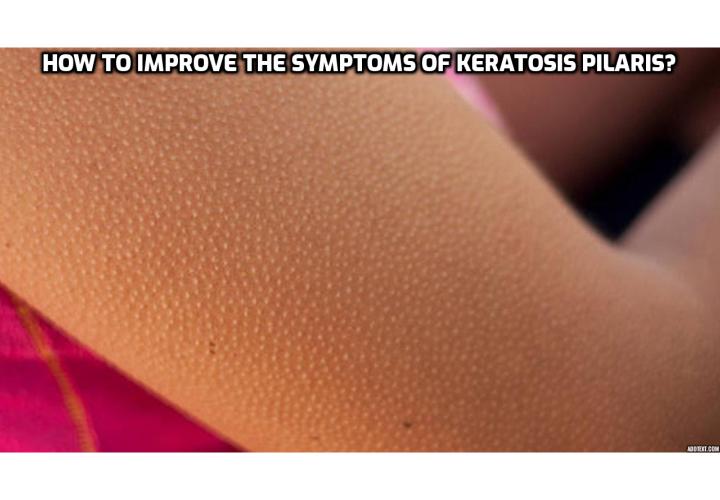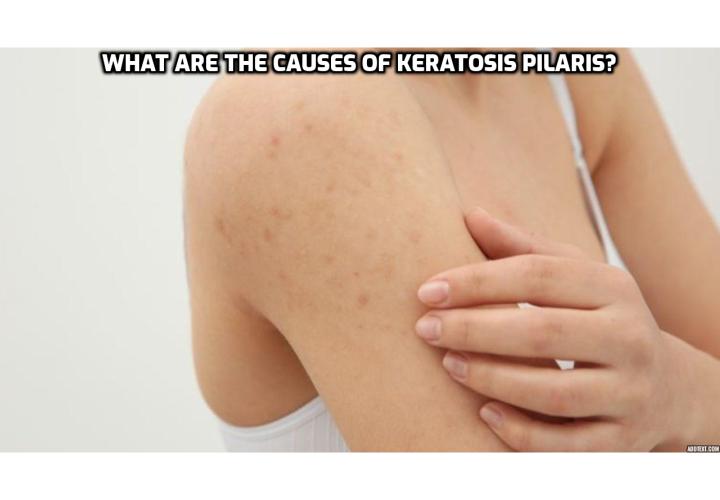How to
Improve the Symptoms of Keratosis Pilaris?
Keratosis pilaris is a common skin disorder that is
caused by the buildup of keratin, a protective skin protein. This buildup forms
plugs in hair follicles, which lead to the trademark symptom of bumpy, rough
skin patches that resemble permanent goose pimples.
This
skin condition creates pale bumps on the surface of your skin; bumps may also
appear red or inflamed for some patients. These coarse, bumpy patches are
generally located on the back of the upper arms, the front of the thighs, and
buttocks, but they can also appear less often along the face, forearms, upper
back, scalp, and eyebrows. Color changes may occur in these bumpy areas,
especially if you pick at or scratch the bumps. Keratosis pilaris patches may become itchy, but
they are rarely painful.
At
just a millimeter or two in diameter, the bumps involved in keratosis pilaris are usually very small. For some
people with this condition, a coiled hair may be visible beneath certain bumps;
this is the result of keratin clogging the hair follicle and preventing the
hair from pushing through the surface of the bump. Keratosis pilaris often worsens in the winter when
humidity is lower, as the lack of moisture tends to dry out skin and exacerbate
any irritation that may be present.
Symptoms
of keratosis pilaris can affect anyone at any age,
although it appears most frequently in young children and adolescents.
Approximately 50% to 80% of all adolescents are affected, as opposed to an
estimated 40% of adults. Generally, the condition resolves in time and does not
create serious medical complications for most patients.
If
you feel concerned about your keratosis pilaris, however, see your family doctor
or a dermatologist. He or she can suggest additional ways to treat your
condition at home, such as using a rich moisturizer on affected skin,
exfoliating regularly, and installing a humidifier to keep your home from
becoming dry.
If
your symptoms of keratosis pilaris still persist after these
treatments, your dermatologist may suggest topical retinoids or corticosteroids
to combat extensive inflammation. In more serious cases, laser treatments may
be an alternative means of improving your skin's texture and appearance.
Improve the
Symptoms of Keratosis Pilaris - What Does Keratosis Pilaris Look Like?
People
with keratosis pilaris experience several trademark
symptoms. These symptoms are the result of the buildup of keratin, which is a
protective skin protein. When keratin continues to accumulate, the hair
follicles become blocked, creating tiny, bumpy patches of skin across the body
resembling rough, permanent goose bumps.
Keratosis pilaris usually involves rough, spiky
areas on the skin that may feel irritated or itchy. These areas are often the
same color as your skin, but they can also become red during inflammation. If
keratosis pilaris is affecting your face, the bumps may resemble acne or give
you a flushed appearance.
Additionally, affected areas of skin can also become dry and
chapped, especially during winter and low-humidity seasons. Occasionally,
coiled hairs are evident beneath the bumps, as they cannot push through to the
surface of the skin and become trapped.
Keratosis pilaris can occur on any skin surface
where hair grows, especially on extremities such as the upper arms, thighs, and
buttocks. The bumps are usually the size of a grain of sand, and they usually
feel like sandpaper. Symptoms of this condition are often worse in the winter
because of low humidity, which leads to dry skin and more obvious skin
problems.
Because keratosis pilaris has a strong genetic association,
multiple members of a family will often demonstrate similar symptoms related to
this condition. If your parents have keratosis pilaris, you have a much higher
risk of developing this skin disorder at some point in your life, and you may
want to consider taking preventative measures. Complications are rare but may
include inflammation or scarring in exceptional cases.
Many individuals with keratosis pilaris find
that the affected patches of skin may appear unattractive. The majority of
patients with this condition report that the rough, uneven texture of their
skin has a poor cosmetic appearance overall. Usually, however, keratosis
pilaris diminishes and may even disappear as patients reach mid-adulthood.
Although keratosis pilaris is not curable, it is usually
treatable. If you suspect you may be suffering from keratosis pilaris, see your
family doctor or a dermatologist to determine the best way to treat your
symptoms.
For more ideas on how to improve the symptoms of keratosis
pilaris, watch this video - TREATING KERATOSIS PILARIS - 3 EASY
STEPS
This post is from the Keratosis Pilaris Remedy
program created by Alison White. Keratosis
Pilaris Remedy program is a step by step natural system through which
you can achieve a smoother and clearer skin in the shortest possible time. It
comes with a confidence-boosting skin cleanse that will help you in getting rid
of the Keratosis Pilaris condition.
You
will also get a recipe for a home-made face scrub with this product that is not
only very affordable to make, but also offer much more benefits as compared to
the expensive products available in the market.
The
author (Alison White) has also included her special Keratosis Pilaris diet
plan that includes some basic foods and make your skin to reborn and glow up
like your younger days.
Furthermore,
you will get the important information about the special ingredients that you
should consider while buying any skin product. These ingredients can be proved
very useful in eliminating the Keratosis Pilaris permanently.
To
find out more about this program, visit Keratosis
Pilaris Remedy Forever


